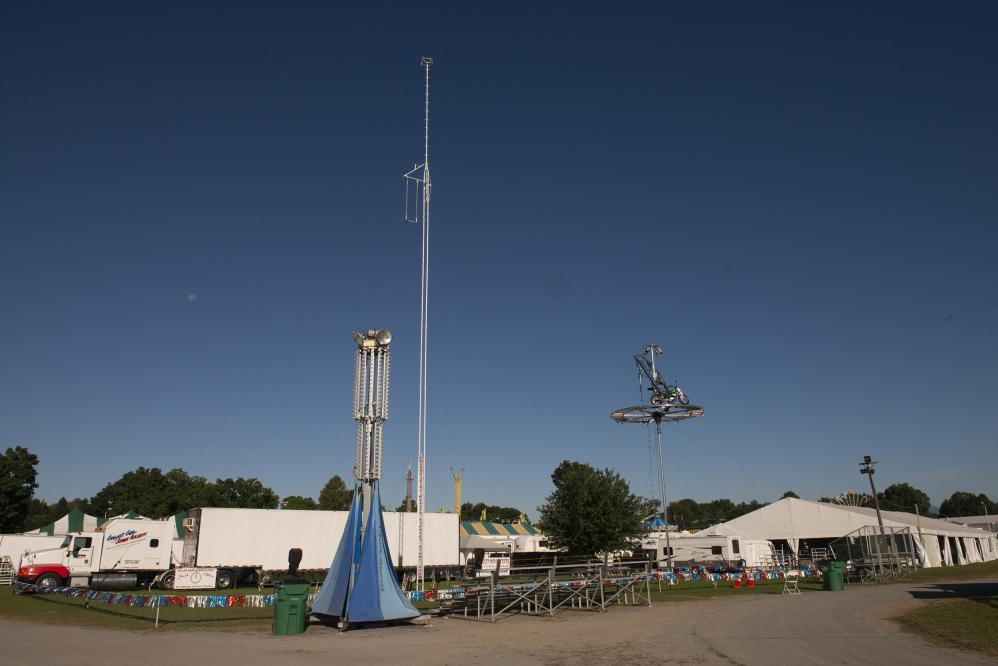Obesity and Obstructive Sleep Apnea
Sleep apnea is a condition in which breathing is temporarily suspended during sleep. There are several forms of sleep apnea, including central, complex and obstructive sleep apnea, of which the latter is the most common. Obstructive sleep apnea (OSA) may involve two different types of breathing interruption: apnea and hypopnea. Apnea occurs when the upper airway becomes obstructed due to collapse of the muscles and soft tissues of the throat during inspiration. Hypopnea is said to occur when the blockage is only partial, resulting in a significant reduction in airflow.
Sleep Apnea May Require a Breathing Mask

Symptoms
Sleep can be divided into two broad categories: rapid eye movement (REM) and non-rapid eye movement (NREM). NREM consists of four distinct levels, ranging from drowsiness to deep sleep. Typically, sleep cycles between these stages multiple times per night, with episodes of deep sleep, sometimes called slow-wave sleep, occurring predominantly towards the start of the night. Deep sleep is the most restorative stage and a certain amount is required in order to maintain wellbeing and wake up feeling refreshed.
During an episode of OSA, lack of oxygen, known as hypoxia, can cause a shift from deep sleep to light sleep or even wakefulness in order to restore regular breathing. Most individuals with OSA are not directly aware of this occurring, but may notice secondary symptoms such as impaired memory or concentration, morning headaches, daytime somnolence (sleepiness) or mood changes, which can arise due to sleep fragmentation.
Heavy snoring is extremely common in those with OSA, and may be interspersed with pauses or episodes of gasping or snorting when breathing is interrupted. Other symptoms can include increased night-time urination or nocturia, reduced libido and a sore throat or dry mouth upon waking.
The symptoms of OSA can have devastating consequences, with daytime somnolence potentially leading to automobile accidents, lack of productivity at work, impaired social function and depression. Results from some observations studies suggest that neurological changes occurring as a result of OSA-induced hypoxia may be implicated in accelerated rates of cognitive decline in older individuals. There is also some evidence to support a link between OSA and increased cancer mortality, although further research is required in order to confirm the association.
How Obesity Affects Obstructive Sleep Apnea
Obesity is a major risk factor for OSA, with a dose-response relationship known to exist between OSA and BMI. What underlies this association remains unclear, though numerous different mechanisms have been proposed:
Carrying excess body weight can lead to an increase in soft tissue mass around the neck area, resulting in a reduced throat size and placing additional strain on the throat muscles so that they are more prone to collapse. Increased body mass around the abdomen can press against the chest wall, such that respiration is impaired, particularly when supine.
Gastroesophageal reflux disease (GERD) often occurs coincidentally with OSA, and both conditions are common in obese individuals. GERD is most frequently caused by weakness or functional abnormality of the lower esophageal sphincter; a valve located within the esophageal junction, between the stomach and the esophagus. There is some evidence to suggest that GERD may cause episodes of OSA by triggering laryngeal (vocal cord) spasms that restrict airflow to the lungs. However, other studies have failed to observe such GERD-related obstructive episodes and an alternative mechanism whereby OSA places repetitive strain upon the gastroesophageal junction, such that it becomes weakened, has also been proposed.
Sleep and obesity are both modulators of metabolic function. Excess weight and central obesity in particular are significant risk factors for insulin resistance and type 2 diabetes, and OSA is also strongly associated with insulin resistance, glucose intolerance and type 2 diabetes independently of obesity. Several studies have reported that episodes of hypoxia can lead to impaired glucose metabolism amongst healthy weight individuals, and one study involving sleep fragmentation achieved via auditory and mechanical stimuli reported that fragmented sleep can result in altered glucose metabolism.
Additionally, there is evidence to suggest that untreated OSA may be associated with poor glucose control in people with type 2 diabetes. These findings have lead some researchers to hypothesize that OSA itself may be a causal factor in the pathogenesis of insulin resistance and type 2 diabetes, and it has also been suggested that OSA may predispose some individuals to weight gain.
Obesity is associated with elevated levels of the hormones ghrelin and resistin, and decreased levels of the hormones adiponectin and leptin. Ghrelin stimulates appetite, whilst leptin acts as an appetite suppressant and also serves to modulate energy expenditure. Several studies have reported correlation between impaired sleep, increased ghrelin levels and decreased leptin production, suggesting that lack of sleep may contribute towards impaired appetite regulation. However, studies investigating the effects of OSA specifically upon these hormones have produced inconsistent results.
Obesity is a known risk factor for hypertension and a dose-response relationship exists between OSA severity and hypertension, independently of obesity. Hypertension is associated with increased risk of developing various life-threatening conditions including cardiovascular disease and stroke, and obesity-related factors such as diabetes and physical inactivity are also known to result in increased cardiovascular risk.
Other Risk Factors
Family history, age and male gender are known risk factors for OSA. The condition can occur at any age, including childhood, but is most common in those aged over 40. Male predominance is thought to be partially accounted for by differences in weight distribution between men and women, with men more likely to carry extra weight around the trunk and neck. There is also some evidence to suggest a role for hormonal factors, as OSA prevalence amongst women increases after the menopause.
Individuals with low muscle tone or physical characteristics such as a receding chin, deviated septum or enlarged tongue, tonsils or adenoids that can result in a narrowing of the airway are also at increased risk of developing OSA. Infections and respiratory conditions resulting in short-term episodes of nasal congestion can lead to temporary OSA, or exacerbate symptoms in pre-existing cases. Modifiable risk factors include smoking, consumption of alcohol and use of sedatives and other drugs with muscle relaxant properties.
Diagnosis and Treatment
OSA symptoms such as heavy snoring and daytime somnolence can be caused by various conditions so a diagnosis of OSA is usually dependent on a combination of medical and sleep history, physical examination and observational studies. In some cases, polysomnography may be carried out during an overnight stay at a specialist sleep laboratory. It typically involves a suite of tests including electrooculograpy, oximetry, electrocardiography, electromyography, and electroencephalograpy, to measure eye movement, blood oxygen levels, heart rhythm, muscle and brain activity respectively, in addition to monitoring of respiratory parameters such as airflow and effort.
Once a diagnosis of OSA is reached, surgical treatment may be recommended if physical factors such as enlarged tonsils or deviated nasal septum are implicated. Lifestyle changes such as weight loss, cessation of smoking or reduction in alcohol consumption may also be advised.
Moderate to severe cases of OSA are often treated with continuous positive airway pressure (CPAP), which involves nightly use of a nasal or oronasal mask connected to a bedside unit that delivers a continuous stream of compressed air at sufficient pressure to prevent airway collapse during sleep. It can take some time to get used to the CPAP regimen, and side effects such as dryness of the nose and throat, mask discomfort, headaches and ear pain have been reported. However, CPAP is generally considered to be a safe and effective treatment for OSA.
Bi-level positive airway pressure (BPAP) systems, which automatically adjust air pressure to rise during inhalation and fall during exhalation, are also available and may be more suitable for individuals with comorbid respiratory conditions such as lung disease. Adaptive servo-ventilation (ASV) systems, which base their output upon the user’s normal breathing patterns, are more expensive than BPAP or CPAP and primarily designed to treat central and complex sleep apneas rather than OSA.
Oral appliances such as mandibular advancement splints, which look somewhat similar to gum shields, are designed to hold the tongue and lower jaw in a slightly forward position in order to tighten the throat muscles and increase space at the back of the throat. If fitted appropriately by a suitably qualified professional, these devices can be effective in treating mild cases of OSA and are also offered as a treatment for non-OSA related snoring.
Other Types of Sleep Apnea
The general condition of sleep apnea is characterized by three different types: Central sleep apnea, Obstructive sleep apnea and Mixed sleep apnea
In central sleep apnea (CSA), the brain falters in sending neurological signals to the respiratory muscles so that these may execute inhalation and exhalation in a timely manner. The evenness of the respiration rate is affected by the inability of the brain's respiratory control centers to respond to the increasing carbon dioxide levels in the blood stream. CSA is often present in individuals, infants included, that have a prevalent heart condition or are on certain medication. The condition can manifest itself even when the subject is awake, but it takes on more serious dimensions if it occurs when the person is sleeping.
People suffering from coronary heart disease may experience angina pains or even a heart attack because of the low levels of oxygen in the blood. Poorly oxygenated blood can trigger sudden seizures even in individuals that do not suffer from epilepsy. Obstructive sleep apnea (OSA) is characterized by the breathing passage becoming obstructed, an unsuccessful attempt at breathing, a drop in oxygen levels, and resumption of breathing during which the subject may gasp for air.
The flow of air may be obstructed if the septum, which separates the two nostrils, is deviated to one or both sides. Poor muscle tone, particularly in obese individuals, can cause the soft tissue at the level of the throat to collapse. The condition is more common in men. Overweight individuals, smokers, aged persons, and diabetics are at increased risk from this condition. Symptoms include snoring, restlessness during sleep, and lethargy during the following day.
The sleeping phase is a period during which the heart can rest and beat at a steady rhythm; however in cases of OSA, the plummeting oxygen levels result in the heart having to pump harder. Blood vessels constrict in order to direct the flow of blood to the brain and vital organs. The constriction results in an increase in blood pressure. OSA is a known risk factor for heart disease and hypertension. It can worsen the already existing condition in patients. In several cases it has been noted that treating OSA can decrease blood pressure and gradually bring it back to normal.
In mixed apnea, the subject experiences episodes of both OSA and CSA. It is often witnessed in people that have a long-standing history of OSA.
Bariatric Surgery and Obstructive Sleep Apnea
Weight loss is associated with reduction in OSA severity, and is also significant in aiding glucose control in diabetic individuals and minimising symptoms of GERD. Bariatric surgery is known to result in reduced OSA severity, but whether it is more effective in this regard than conventional weight loss techniques is currently not clear. A recent study found no difference in OSA reduction between individuals who underwent a bariatric procedure compared to those who lost weight via lifestyle modifications alone, although the bariatric group achieved significantly greater weight loss over the two-year study period.
Longer-term studies have observed that whilst weight loss achieved through dieting can lead to resolution of OSA, subsequent regain of weight, accompanied by the return of OSA within a few years, is significantly more common in those who lost weight via dietary interventions alone when compared to individuals who lost weight following bariatric surgery. Bariatric surgery has also been shown to result in improved sleep quality and duration in morbidly obese individuals.






